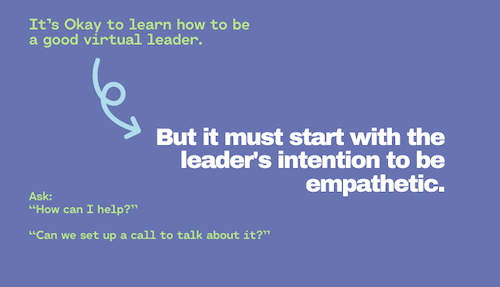“Leadership is a muscle you practice”
It’s okay to learn how to be a strong virtual leader because, as Simon Senek says, “leadership is a muscle you practice,” and most of the time, people are not taught how to lead. And if leadership is a gym, you can learn how to be a good coach and motivate virtual teams by tapping into everyone’s strengths and potential.
But it must start with the leader’s intention to be empathetic and show emotional intelligence.
This virtual skill for the managers is called: “putting yourself in the shoes of your team members” and making sure they don’t need more time or support to perform the job.
When the manager needs to wear his coach hat, it means shifting your perception with the team member’s perspective to enter into a deep listening mode.
And you can ask a simple question: “How can I help?” or “Can we set up a call to talk about it?”
But the hardest part of the virtual world is to take the time and energy to connect with the team member when it’s getting more personal.
My advice here is to disconnect these critical discussions from the daily flow as much as possible by finding time with maximum brainpower, for example, early in the morning. Or when it’s possible to take a break right after the discussion. It’s easy to sacrifice or put-off actions that appear to provide only short-term value, but it’s the only way to avoid being the fireman later on.
Coaching sessions make anxious managers because you assume you can’t help, you can’t change the person, or simply don’t have the energy for it.
But remember, it can be as simple as listening to the person to acknowledge and understand the difficulties and ask how she can solve them. Most of the time, the sole value of listening can empower and give the confidence to solve the issue.
No need to be an expert to be a great coach
Let me share one of my first coaching successes. A few years ago, I took on a team whose previous manager was fired. My recruitment took a while, and when I arrived, the team had been on their own for six months. They had reported to the VP during the time-lapse and were very satisfied. I arrived as the useless mid-manager having difficulty connecting with the team during the first weeks until one had a problem. I had no clue as to all the names dropped by my team member and struggled to understand his story.
My ignorance helped me a lot.
I had no choice but to listen to him until the end and ask him the critical question that appeared to be the turning point in our relationship. “OK, I understand now what you are facing. So, based on your experience, how can you solve the problem?” I saw his face illuminating, and I was surprised by the impact of the question, noticed it, and just shut my mouth to listen carefully and learn with the force of details what could be the best plan for his later success.
This kind of coaching conversation can work even better on the phone because it doesn’t create the discomfort of feeling scrutinized. Expressing emotions can feel safer without video, especially for introverted people.
For extraverts, they will prefer video calls. Thus, the manager might benefit from asking the preferred mode of communication for the coaching session.


